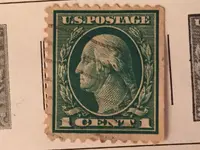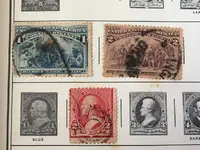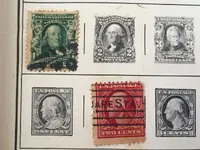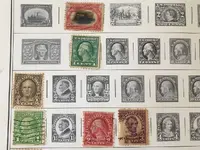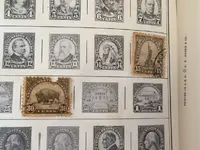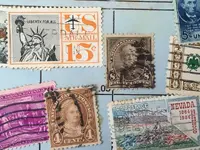You are using an out of date browser. It may not display this or other websites correctly.
You should upgrade or use an alternative browser.
You should upgrade or use an alternative browser.
Is it the rare one
- Thread starter cheech
- Start date
although I had a somewhat decent collection at one time,
and do like looking at peoples collections.
I never got into Valuing them, So I can't really help you out.
other then this looks sort of like it
United States Stamp Values - 1914-1916 Regular Issues - Includes Washington-Franklins
and do like looking at peoples collections.
I never got into Valuing them, So I can't really help you out.
other then this looks sort of like it
United States Stamp Values - 1914-1916 Regular Issues - Includes Washington-Franklins
At my last count there were 21 varieties of that stamp, including coils and imperforates.
Tomorrow, I'll see what I can do to narrow it down.
Don.....
Tomorrow, I'll see what I can do to narrow it down.
Don.....
Slingshot
Bronze Member
- Joined
- Apr 3, 2004
- Messages
- 1,074
- Reaction score
- 1,206
- Golden Thread
- 0
- Location
- Southern Appalachia
- Detector(s) used
- Whites CM2 BFO, Harbor Freight 9 function, BH Pioneer 202, Fisher F22
- Primary Interest:
- All Treasure Hunting
The Washington - Franklin series is one of the most complex issues ever put out by the US Post Office. They all need to have their watermark checked, perforations measured, engraving checked, and some need the design measured in mm, some also have different paper, some shades are also important. It's a process of elimination to determine exactly which stamp you have. There is an excellent flow chart guide for doing this process in the front of the Scott's Specialized Catalogue of US Stamps.
Most of these stamps from that series are common, but a few still exist in the wild that are very valuable and to the naked eye look exactly like one of the more common varieties. Several of the rare ones seem to pop up every year, found by collectors ploughing through this series.
The stamp you are asking about has 29 recognized varieties.
Most of these stamps from that series are common, but a few still exist in the wild that are very valuable and to the naked eye look exactly like one of the more common varieties. Several of the rare ones seem to pop up every year, found by collectors ploughing through this series.
The stamp you are asking about has 29 recognized varieties.
I'll defer my intended effort to suggesting you follow up with Slingshot's recommendation: "Scott's Specialized Catalogue of US Stamps".
Be thankful you didn't find the 2 cent stamp from the same series; my price guide lists 34 varieties of that stamp.
Don.....
Be thankful you didn't find the 2 cent stamp from the same series; my price guide lists 34 varieties of that stamp.
Don.....
Slingshot
Bronze Member
- Joined
- Apr 3, 2004
- Messages
- 1,074
- Reaction score
- 1,206
- Golden Thread
- 0
- Location
- Southern Appalachia
- Detector(s) used
- Whites CM2 BFO, Harbor Freight 9 function, BH Pioneer 202, Fisher F22
- Primary Interest:
- All Treasure Hunting
The best watermark fluid is Ronsonol lighter fluid, for the old fashioned metal re-fillable cigarette lighters, and it's a fraction of the cost of the "specialized watermark solutions". I and many other collectors have used it successfully for years. On some foreign stamps that were printed with what is known as "fugitive ink" any solution will ruin them as the ink will combine with the solution and run off the paper, hence the name. These are listed in stamp catalogs with a warning about using solution on them, but I am unaware of any US stamps printed with that type of ink, and I've dunked 10's of thousands of them, just make sure you aren't smoking, around any open flame, and in a well ventilated area.
Instead of purchasing a special watermark tray, usually only about $1, but still $1 saved, is to use a clear glass ashtray, pyrex bowl, or something along those lines, and just place it over a black piece of cloth, paper, anything black, and it will work as well as the trays they sell for this. Also watermark fluid can be saved after use, if you have a glass container with some kind of airtight lid. It doesn't take much though to see the WM's, and might not be worth the hassle to you to save it after use. I'll run a batch of stamps through at a time, and them pour off any remaining fluid into one of those little airline liquor bottles to be used again, but I'm a cheapskate.
Looking at your stamps, I don't see anything spectacular, but it is definitely the nucleus off a collection. When you pull a stamp off the album page, you want to peel the hinge that it is mounted with from the album page, and not from the stamp, as that can damage it, and make a thin spot on it's paper surface which detracts from value. You then will need to soak the stamp in warm water for about 10 minutes, and the hinge on it's back, along with any paper will float off. The next step is to dry it, and you lay it facedown on a towel laying on a flat surface. If you lay it face up, with the design showing, the stamp will dry and curl into a small tube, and you will have to soak it again. It will dry in an hour or 2 depending on temp and humidity. Then you will want to keep it in a paper envelope, and it will eventually flatten out. You can speed this flattening process by doing what is known as pressing, and you put the stamp in an old hardback dictionary, the ink on these won't get onto the stamp, but most other books, except a bible printed on India paper, will bleed ink from the printed letters onto the stamp and ruin it. Then just leave it in there a couple of hours and it will be pressed nice and flat.
Only other thing I can think of you will want to get a pair of specialized "stamp tongs", and even my cheapskate self have never found a substitute for these. I've tried tweezers and they absolutely will not work right for stamps, and even have a tendency to do damage. I have the old school steel stamp tongs but understand they are being made of plastic too now, and are less expensive than the metal ones. Handling stamps with your bare fingers is okay when you are soaking them, but once they are dry they will absorb oils from your skin and degrade, also fingers are pretty clumsy compared to the tongs when handling dry stamps once you become accustomed to them.
Good luck with your stamps!
Instead of purchasing a special watermark tray, usually only about $1, but still $1 saved, is to use a clear glass ashtray, pyrex bowl, or something along those lines, and just place it over a black piece of cloth, paper, anything black, and it will work as well as the trays they sell for this. Also watermark fluid can be saved after use, if you have a glass container with some kind of airtight lid. It doesn't take much though to see the WM's, and might not be worth the hassle to you to save it after use. I'll run a batch of stamps through at a time, and them pour off any remaining fluid into one of those little airline liquor bottles to be used again, but I'm a cheapskate.
Looking at your stamps, I don't see anything spectacular, but it is definitely the nucleus off a collection. When you pull a stamp off the album page, you want to peel the hinge that it is mounted with from the album page, and not from the stamp, as that can damage it, and make a thin spot on it's paper surface which detracts from value. You then will need to soak the stamp in warm water for about 10 minutes, and the hinge on it's back, along with any paper will float off. The next step is to dry it, and you lay it facedown on a towel laying on a flat surface. If you lay it face up, with the design showing, the stamp will dry and curl into a small tube, and you will have to soak it again. It will dry in an hour or 2 depending on temp and humidity. Then you will want to keep it in a paper envelope, and it will eventually flatten out. You can speed this flattening process by doing what is known as pressing, and you put the stamp in an old hardback dictionary, the ink on these won't get onto the stamp, but most other books, except a bible printed on India paper, will bleed ink from the printed letters onto the stamp and ruin it. Then just leave it in there a couple of hours and it will be pressed nice and flat.
Only other thing I can think of you will want to get a pair of specialized "stamp tongs", and even my cheapskate self have never found a substitute for these. I've tried tweezers and they absolutely will not work right for stamps, and even have a tendency to do damage. I have the old school steel stamp tongs but understand they are being made of plastic too now, and are less expensive than the metal ones. Handling stamps with your bare fingers is okay when you are soaking them, but once they are dry they will absorb oils from your skin and degrade, also fingers are pretty clumsy compared to the tongs when handling dry stamps once you become accustomed to them.
Good luck with your stamps!
Slingshot
Bronze Member
- Joined
- Apr 3, 2004
- Messages
- 1,074
- Reaction score
- 1,206
- Golden Thread
- 0
- Location
- Southern Appalachia
- Detector(s) used
- Whites CM2 BFO, Harbor Freight 9 function, BH Pioneer 202, Fisher F22
- Primary Interest:
- All Treasure Hunting
OK, I double checked on the fugitive ink that will run under watermark fluid in US stamps and discovered there are two stamp issues that fall in this category. They are #1260 Amateur Radio commemorative 5c issue of 1965 & #1832 Education commemorative 15c issue of 1980. Just to clear that up, but why anybody would be watermarking these stamps is a mystery to me.
Watermark paper was used in the US from 1895 to 1916; its main purpose was as a security measure against counterfeiting. A little secret among stamp collectors that Slingshot shared with you is to use Ronsonol brand lighter fluid. It evaporates more slowly and will reveal watermarks that the commercial fluids miss.
Don.........
Don.........
Sleepwalker_9
Tenderfoot
- Joined
- Mar 1, 2015
- Messages
- 9
- Reaction score
- 14
- Golden Thread
- 0
- Detector(s) used
- Deus XP
- Primary Interest:
- All Treasure Hunting
Like the others have already mentioned there are several variations of that stamp.
To identify that stamp you will need to check the perf size on the vertical and horizontal.
You then need to measure the outer stamp design (not the paper) to the nearest 1/2 mil.
Then check to see if it has a watermark
... personally I never use any chemical on stamp to check for watermarks. I have several over methods which find as effective and less .... colored light filtration or a watermark inkpad are my first choices.
If I were to take a guess at the stamp,
I would think its the 1917-1919 issue "SC 525" perf 11 x 11, unwatermarked .... value around 25c-50c if the stamp has no thins as it is quite a common stamp.
I see collections like you have there by the truck load at every auction I go to. You have $2 - $3 of stamps in those photos if you were to purchase them as a lot.
To identify that stamp you will need to check the perf size on the vertical and horizontal.
You then need to measure the outer stamp design (not the paper) to the nearest 1/2 mil.
Then check to see if it has a watermark
... personally I never use any chemical on stamp to check for watermarks. I have several over methods which find as effective and less .... colored light filtration or a watermark inkpad are my first choices.
If I were to take a guess at the stamp,
I would think its the 1917-1919 issue "SC 525" perf 11 x 11, unwatermarked .... value around 25c-50c if the stamp has no thins as it is quite a common stamp.
I see collections like you have there by the truck load at every auction I go to. You have $2 - $3 of stamps in those photos if you were to purchase them as a lot.
FC-Treasure
Full Member
I am currently using the Micarelli Identification Guide to US Stamps, Regular Issues 1847-1934. It gives you a a list of attributes for the 25 varieties of Washington 1 cent (1912-1921) that you posted. I have to tell you, this whole Franklin/Washington series is pretty hard to identify and is usually something that only serious stamp collector's get into. I've got a perforation guide for measuring the perfs, a color guide for determining the color, reference stamps to compare to, an electronic microscope, and a fair bit of experience and I still get stumped on this variety due to weathering, age, fading, and other issues that can change the look of a stamp.
Anyway, I do recommend the Micarelli guide, it is pretty useful if you are really into US stamps. Used copies might be cheaper... The Micarelli identification guide to U.S. stamps Revised Edition Charles N. Micarelli 0894872826 9780894872822
One anecdote... I knew a guy once that specialized in this series of stamps (all denominations, franklin and washington). Because they are so hard to identify, people tend to sell them without identifying them, assuming they are the variety that are worth nothing, so he would buy up everything that looked promising. He actually made a fair bit of money with this strategy because every now and then he would get a stamp worth $100 (or more) for next to nothing.
Anyway, I do recommend the Micarelli guide, it is pretty useful if you are really into US stamps. Used copies might be cheaper... The Micarelli identification guide to U.S. stamps Revised Edition Charles N. Micarelli 0894872826 9780894872822
One anecdote... I knew a guy once that specialized in this series of stamps (all denominations, franklin and washington). Because they are so hard to identify, people tend to sell them without identifying them, assuming they are the variety that are worth nothing, so he would buy up everything that looked promising. He actually made a fair bit of money with this strategy because every now and then he would get a stamp worth $100 (or more) for next to nothing.
Last edited:
tomhoke
Tenderfoot
- Joined
- Dec 13, 2014
- Messages
- 4
- Reaction score
- 4
- Golden Thread
- 0
- Primary Interest:
- All Treasure Hunting
The stamp pictured is a Scott 498 flat plate (19mm x 22mm) perf 11 (horiontal and vertical) issued in 1917-19 worth $0.25 used. I used an I-pad program called Juxtaposer to put your stamp in the background then overlay it with a known Scott 498....and it matches perfectly. Stamp collecting is like treasure hunting, and you were on the right track: several of the perf 11 Washington 1 cent stamps are extremely rare and run into the thousands of dollars. If you are interested in stamp collecting most public libraries have Scott catalogues, and there are wonderful articles about the early Washington and Franklin series of stamps on the internet. Good luck!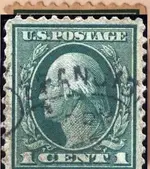


FC-Treasure
Full Member
The stamp pictured is a Scott 498 flat plate (19mm x 22mm) perf 11 (horiontal and vertical) issued in 1917-19 worth $0.25 used. I used an I-pad program called Juxtaposer to put your stamp in the background then overlay it with a known Scott 498....and it matches perfectly. Stamp collecting is like treasure hunting, and you were on the right track: several of the perf 11 Washington 1 cent stamps are extremely rare and run into the thousands of dollars. If you are interested in stamp collecting most public libraries have Scott catalogues, and there are wonderful articles about the early Washington and Franklin series of stamps on the internet. Good luck!View attachment 1202276
Pretty cool... Question, how did you know it wasn't a scott 525 even after matching the size/perfs with Justaposer? Are you basing it on color or is there a easier way to distinguish between flat plat printing and offset press printing?
tomhoke
Tenderfoot
- Joined
- Dec 13, 2014
- Messages
- 4
- Reaction score
- 4
- Golden Thread
- 0
- Primary Interest:
- All Treasure Hunting
Mystic Stamp has a good writeup about offset stamps such as the Scott 525. Because of the process used to create the offset stamp, definition suffers and the offset stamp detail is not as good, resulting in a loss of quality. A flat plate stamp can be felt, and an offset stamp feels smooth (for those people who have a good sense of touch.) My Scott 525 looks like the example on Mystic Stamps....kinda washed out or faded looking and not as clear and sharp as the stamp being identified....which looks like my 42 copies of Scott 498. The answer to the question: "Is it the rare one?" is: "No, it is not, but it might have been." 

Similar threads
- Replies
- 11
- Views
- 2K
Users who are viewing this thread
Total: 1 (members: 0, guests: 1)

